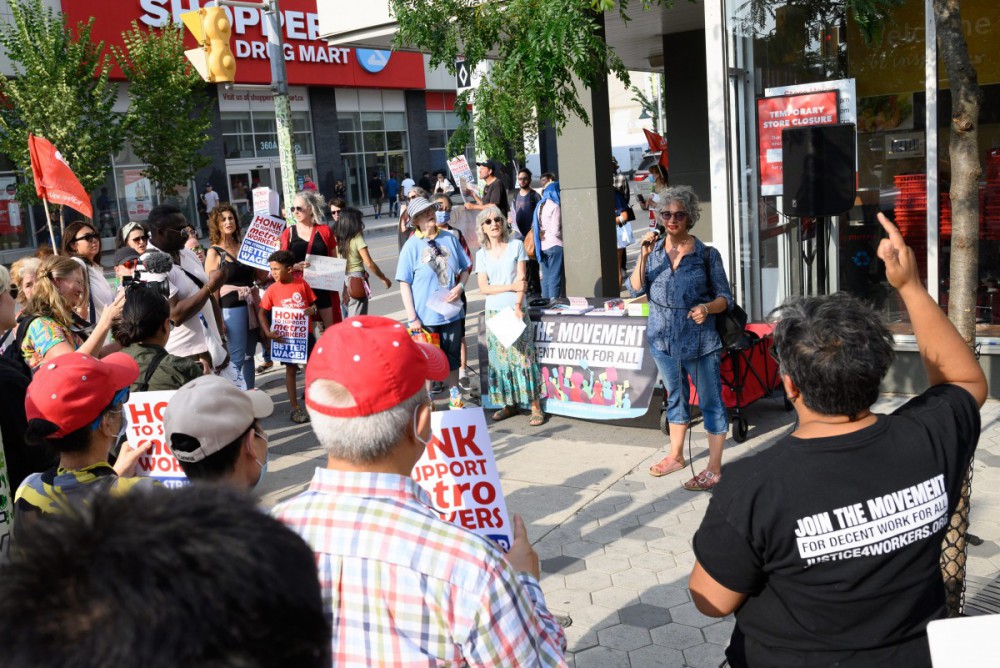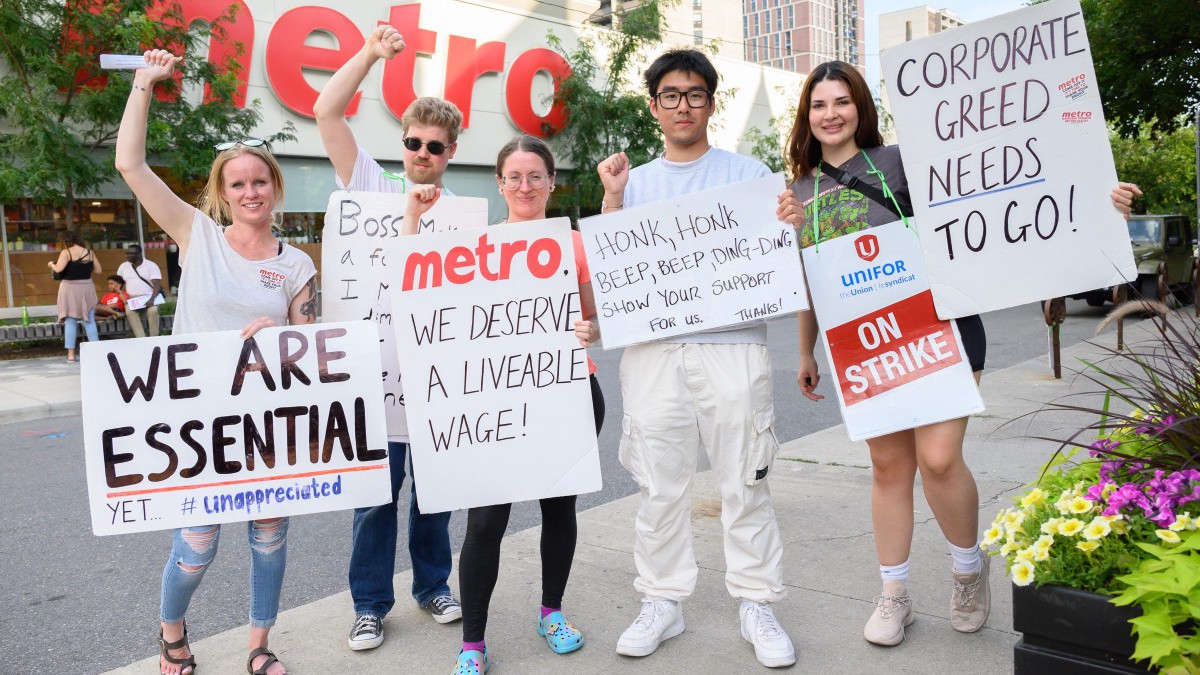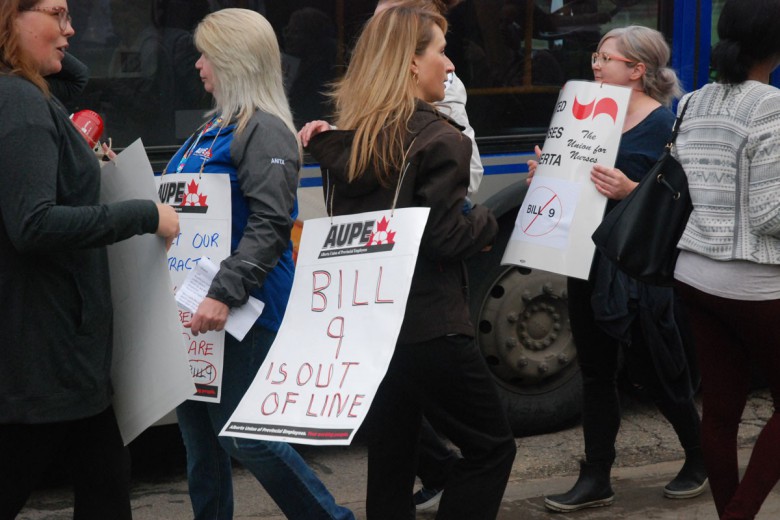On July 29, 2023, Metro grocery store workers in the Greater Toronto Area rejected their tentative agreement and went on strike. The workers are among a string of high-profile strikes this summer, including port workers in B.C. and government workers unionized with the Public Service Alliance of Canada across the country.
The cost-of-living crisis and record inflation levels are driving workers to demand significant wage gains in 2023. Inflation averaged 6.8 per cent in 2022 and wage increases of unionized workers fell behind, with major union settlements of 500 workers or more averaging a mere 2.5 per cent. As workers gather on the picket lines and strategize for the bargaining table, understanding the causes of inflation, economic conditions, and their implications for bargaining and worker power is essential to ensuring capital does not increase its power at the expense of workers in the “post-pandemic” economy.
Understanding pandemic-era inflation
Inflation in Canada began to rise more acutely in early 2021 and really began to bite in June 2022 when it reached 8.1 per cent, a 39-year high. Economists warned that Canada could see a return to the stagflation of the 1970s, when there was a wage-price spiral – that is increased wages caused the prices of goods to rise. In turn, workers and unions demanded wage increases to keep up and it became a feedback loop.
When inflation peaked in 2022, economists claimed workers’ wages were responsible, but there is little evidence of a wage-price spiral like that of the 1970s today. In other words, wage increases are not driving pandemic-era inflation.
“A key thing that is different from today is that unions and the working class were much more organized [in the 1970s],” says Todd Gordon, an associate professor of law and society at Wilfred Laurier University. “I think that the capacity to fight was important. That capacity to fight was part of [governments’] decision to turn toward neoliberalism.”
With a demobilized labour movement battered by neoliberalism, falling unionization in the private sector, and lowered worker expectations, governments around the world, including Canada’s, focused on lowering inflation. That affects how much workers can demand and how much governments are willing to negotiate.
“We are in a unique moment, where, during the pandemic, people noticed and appreciated those workers that they needed most, like health-care workers, service-sector workers, food-delivery and supermarket workers."
As Gordon notes, unemployment levels in Canada did not return to their pre-pandemic level until February 2022, when inflation was already rising. Labour’s share of the GDP (gross domestic product) – that is, the amount of Canada’s national income used for wages – was 44 per cent at the end of 2022, although it had been this rate as recently as 2019. In the second quarter of 2020 it peaked 46.8 per cent, a level not seen since the early 1990s. These numbers show that workers’ incomes are an unlikely cause of the current inflation. While some workers have made gains, two-thirds of workers are seeing their wages decline due to (and are unable to catch up with) inflation. Even the International Monetary Fund sees little evidence of wages having a major impact on inflation globally. While some workers have made gains, wage increases aren’t widespread enough to cause a wage-price spiral.
Another possible explanation for inflation is too much money chasing too few goods. A Parliamentary Budget Officer report stated that pandemic benefits like the Canada Emergency Response Benefit boosted spending power and outpaced inflation. But when the benefit programs were shut down, inflation continued to rise, eating into purchasing power.
The causes of this bout of inflation have been subject to debate. One likely culprit is supply-chain issues. Some of the clearest examples of this was the rise in the price of microchips, cars, and, most importantly, shipping. The Russian invasion of Ukraine has also contributed to inflation since Russia is a major fertilizer, oil, and gas exporter, and both countries are major grain exporters.
A popular explanation among leftists is that corporate profits are to blame for inflation, and it is easy to believe this theory in light of the profits Canadian grocery stores and oil companies are posting. But Gordon explains that it is more complicated than that.
Whatever the cause of inflation, working-class people are hit hardest by it even though they are not responsible for it.
“I am a little bit skeptical and cautious on corporate profits,” Gordon says. “Some companies have profited handsomely, but my caution is that profits weren’t increasing on the whole for capital. There wasn’t a big spike in profitability across the whole economy.”
A recent study by the Bank of Canada found that the greatest rise in prices happened at the beginning of the pandemic, when the government imposed COVID-19 restrictions. Inflation was low, and a Statistics Canada report notes that apart from natural resources, corporate profit margins were flat and declined in many other sectors. So profits alone cannot be the sole reason for inflation, especially in light of the level of supply-chain disruption. Though economists disagree on the single largest driver of inflation, they almost all agree that there are multiple causes at play.
In fact, the low inflation of the last 30-plus years might no longer be possible. With trends heading toward deglobalization in some sectors and China’s population levelling off, companies may no longer be able to rely on cheap labour globally, which means higher inflation over the longer term. It is also possible that the world’s labour pool has peaked, and workers in many countries in the Global North and South will have increased leverage.
Harnessing worker power
Whatever the cause of inflation, working-class people are hit hardest by it even though they are not responsible for it. And workers are fighting back and demanding more.
“We are in a unique moment, where, during the pandemic, people noticed and appreciated those workers that they needed most, like health-care workers, service-sector workers, food-delivery and supermarket workers,” says Peggy Nash of the Centre for Labour Management Relations at Toronto Metropolitan University.
Striking Metro workers and supporters gather to listen to Helen Victoros, president of the Elementary Teachers of Toronto union. Photo by Jared Ong.
“It exposed the inequality that those very workers faced; inequality in terms of low pay, benefits, and insecure working conditions. It really highlighted the state that our society is in in terms of inequality, and those who were on the short end of the economy were often racialized newcomers, women disproportionately.”
While it is premature to call this year’s strikes a strike wave, there has certainly been an uptick in work stoppages. As Gordon points out, historically, “it’s not uncommon when there’s inflation to see an increase in strike activity.”
“It’s a very good time to be at the bargaining table. One of the things driving up our success at the bargaining table is the tight labour market."
There are several factors at play favouring workers, one of the most important being the tight labour market. “It’s a very good time to be at the bargaining table. One of the things driving up our success at the bargaining table is the tight labour market,” says Marty Warren, national director of United Steelworkers Canada (USW).
These conditions have led to some small but important victories. In a reverse of the bargaining results that occurred during the Great Recession, the USW has managed to eliminate certain two-tier provisions in some newly negotiated contracts. Two-tier provisions have been particularly corrosive to solidarity between newer and older workers, as under such provisions it often took new hires longer to reach the top wage or they had access to fewer benefits.
On the employer side, Warren also notes that with a tight labour market and workers more willing to change jobs, businesses are also looking to keep down the costs related to hiring and training new employees. Warren adds that “inflation cuts both ways,” even if workers still bear the brunt. And unlike previous generations like the Baby Boomers, younger workers are more likely to live at home, making leaving a job a little less risky. In this current environment, “employers want to keep people employed,” says Warren.
“Whether it’s the federal public service or education workers, we’re seeing increasingly that workers are acutely aware of their power. They are aware of the inequality, and they are prepared to use their power to make gains.”
Another important trend is workers rejecting tentative agreements – an agreement between unions and employers outlining working conditions that is voted on by the union membership. By rejecting their tentative agreements, workers show they are willing to remain off the job to secure a better deal. In addition to Metro workers in the Greater Toronto Area and port workers in B.C., since the pandemic began in 2020, workers at Telus, Windsor Salt, Ontario public broadcaster TVO, Olds College of Agriculture & Technology in Alberta, Community Living Manitoba, hospital administration and school support workers in Nova Scotia, Newfoundland public sector workers, and steelworkers in B.C. have rejected agreements. “If you want to go back six or eight years ago, you didn’t see this,” notes Warren.
Nash adds, “Whether it’s the federal public service or education workers, we’re seeing increasingly that workers are acutely aware of their power. They are aware of the inequality, and they are prepared to use their power to make gains.”
Many of these – but by no means all – rejected agreements have occurred in the public sector, which reveals several things.
First, federal and provincial governments might be more hesitant to use back-to-work legislation now than in previous years. This legislation is used to forcibly end a strike or lockout without an agreement being reached with workers. Doug Ford imposed back-to-work legislation to force education workers back on the job in Ontario in late 2022, but he scrapped the bill amid public outrage and once the union returned to the bargaining table. The federal government used the legislation to force Montreal port workers back to work in May 2021. Over two years later in July 2023, Labour Minister Seamus O’Regan threatened the legislation, but ultimately didn’t use it against port workers striking in B.C.
Since 2020, workers at Indigo, Starbucks, Google, WestJet, and Canada Goose have won union certification. Workers are organizing industries that are typically not unionized, demonstrating workers’ frustrations with their conditions and expanding the movement.
Enforcing back-to-work legislation has been a very popular method of regulating labour relations for governments in Canada in the neoliberal era. During the last major bout of inflation in the mid-1970s, both levels of governments ordered striking workers back to work, imposed contracts, and even opened already negotiated contracts and altered them.
The use of back-to-work legislation is a gross violation of workers’ rights – Supreme Court of Canada rulings have even called into question the validity of the legislation. Provinces can also use the notwithstanding clause, which allows them to ignore Supreme Court rulings, and while Charter challenges to this legislation take years to get through the courts, they can set important precedents. It took nearly seven years of court challenges before the Supreme Court struck down Saskatchewan’s essential services legislation but limiting many public sector workers’ right to strike.
In terms of the private sector, unionization rates have steadily fallen over the past several decades. But during the pandemic, workers organized at companies where unions had previously largely been absent. Since 2020, workers at Indigo, Starbucks, Google, WestJet, and Canada Goose have won union certification. While these victories are a far cry from the massive expansion of unionization in the 1930s and ’40s, workers are organizing industries that are typically not unionized, demonstrating workers’ frustrations with their conditions and expanding the movement.
Organizing to undercut capital
There are many challenges ahead for the labour movement. The Bank of Canada keeps raising interest rates, risking a recession, higher debt costs, and an end to the tight labour market. The housing bubble could also burst because of high interest rates. In April 2023, Bank of Canada governor Tiff Macklem stated that more temporary foreign workers will help employers fill job vacancies. Moreover, for years, unions have relied on concessionary bargaining and courts to solve disputes with governments and backed off from organizing precarious workers, instead cutting sweetheart deals with companies like Uber. And even though many sectors – like grocery stores and oil – are making record profits, worker organizing always risks triggering backlash from business and government eager to discipline the working-class with threats of high unemployment and anti-worker laws.
In this economic climate, unions must organize strategically to undercut capital. That means pushing for permanent residency status for all temporary foreign workers, unionizing gig workers, and raising the floor for all workers. That could include coordinating sectoral bargaining, (ie.fighting for everyone across an industry to receive the same wages regardless of the company they work for) and refusing concessions. After decades of lowered worker expectations, it’s time the labour movement shows workers they can demand more. Workers have more leverage right now than they’ve had in decades. It’s time they seize the moment, organize, and build power.







